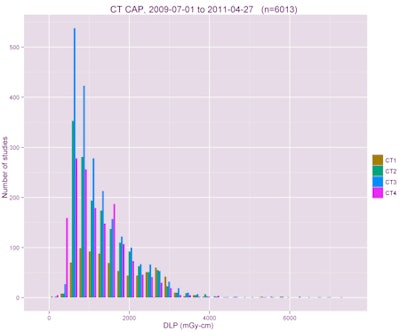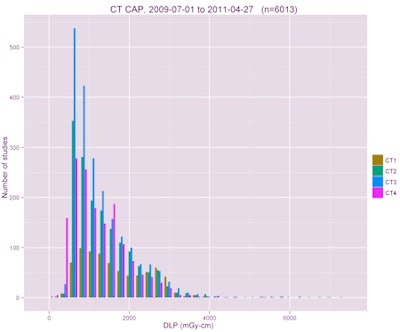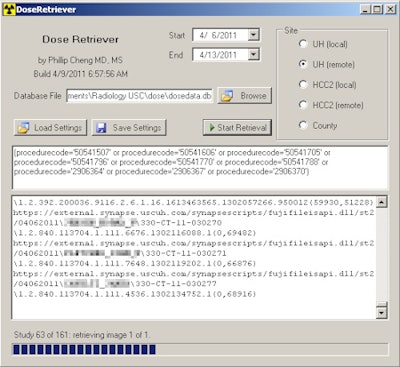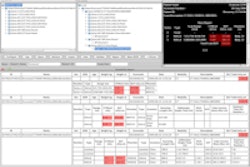
Legacy CT systems still encode patient dose information in a manner not amenable to automated retrieval and processing. But software developed by a University of Southern California (USC) radiologist can help tackle that problem, according to a presentation at the recent 2011 American Roentgen Ray Society (ARRS) meeting.
DoseRetriever acquires and decodes CT dose information from the institution's PACS and incorporates it into a database for data mining and monitoring. The entire retrieval, decoding, database, and analysis system runs portably off a USB flash drive on any PACS workstation without any extra software installation or reconfiguring of PACS workstations or CT scanners, according to presenter Dr. Phillip Cheng, an assistant clinical professor of radiology at USC.
For all but the newest CT scanners, CT dose data are stored as graphical screen captures that don't lend themselves well to computerized analysis, Cheng said. At USC, data are also decentralized among four different sites and three separate PACS databases. In addition, the institution also has nine scanners from the four major OEM manufacturers, each of which uses a different presentation format and font for dose screen captures, Cheng said.
A number of researchers have recently developed similar projects using optical character recognition (OCR) techniques. Cheng began his own development effort by first using OCR technology for the dose screen captures. Not satisfied with currently available OCR programs, Cheng devised his own system by collecting dose screens from all the different scanners and manually decomposing them into fonts.
"The resulting fonts can be used for nearly perfect character recognition," Cheng said.
After an initial attempt at using brute-force bitmap matching for OCR, Cheng settled on a simple checksum hashing technique to realize significant improvements in speed.
Next, Cheng sought to create a method to automate the downloading of dose data from the PACS. The institution's Synapse PACS software (Fujifilm Medical Systems USA) employs a Web-based architecture; client workstations communicate with the PACS Web server via SQL queries posted via HTTP.
The Web server serves as a front end to an Oracle database, which returns records that include, among other things, URLs for DICOM objects on an image server, Cheng said.
"Since all communications with the servers occur over HTTP, I first built a PACS query tool that sends SQL statements to the Web server to retrieve information for all studies in a certain date range and with a certain procedure code," he said. "And from there it's fairly straightforward to add subqueries to isolate the dose screens within those studies."
The portable toolkit combines the OCR code and the PACS retrieval code, automatically retrieving and decoding the dose screens from the PACS and incorporating the data into a portable SQLite database.
"I then have scripts written for the open-source R statistical environment to automatically generate summary statistics and graphs," he said.
 |
| Histogram of chest/abdomen/pelvis CTs performed at one of USC’s sites. All images courtesy of Dr. Phillip Cheng. |
DoseRetriever's graphical user interface allows users to specify the date range, the procedure codes, and the PACS database being used, Cheng said.
 |
| Graphical user interface of DoseRetriever. |
Cheng, an abdominal radiologist, has been utilizing DoseRetriever for abdominal studies since July 2009. From that date to April 2011, 24,005 CT abdomen studies have been processed with no numerical OCR errors detected, he said.
He also performed an analysis for the month of March 2011 to see what CT studies were missing in his database. DoseRetriever captured 1,429 of 1,441 abdominal CT exams, for a capture rate of 99%.
"The missing dose data was due to a process issue where dose screens for the abdominal study were stored under chest studies with a different accession number," he said. "This is a process issue we're still trying to resolve completely."
Summary statistics and graphs are automatically generated by scripts in the R statistical environment, according to Cheng.
The experience indicates that large-scale dose monitoring can be performed with limited resources, even without access to a dedicated computer, Cheng said.
"This is a work-in-progress, but I will be making the code available on my university Web page for anyone who is interested," Cheng said.
Cheng noted that while the OCR function should be adaptable for use with any PACS, the dose retrieval function is designed specifically to work with the Web-based architecture of Fuji's Synapse PACS software.




















